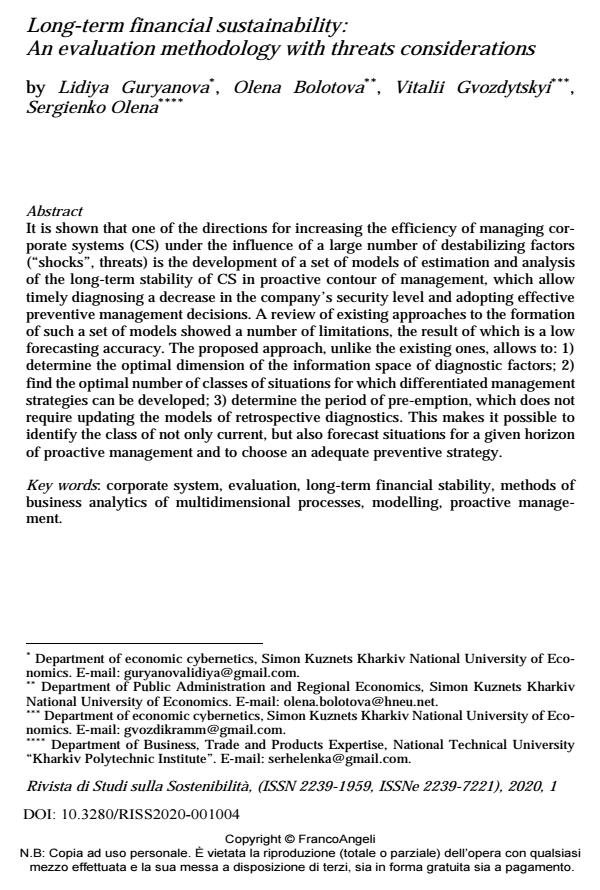Long-term financial sustainability: An evaluation methodology with threats considerations
Titolo Rivista RIVISTA DI STUDI SULLA SOSTENIBILITA'
Autori/Curatori Lidiya Guryanova, Olena Bolotova, Vitalii Gvozdytskyi, Sergienko Olena
Anno di pubblicazione 2020 Fascicolo 2020/1
Lingua Inglese Numero pagine 23 P. 47-69 Dimensione file 270 KB
DOI 10.3280/RISS2020-001004
Il DOI è il codice a barre della proprietà intellettuale: per saperne di più
clicca qui
Qui sotto puoi vedere in anteprima la prima pagina di questo articolo.
Se questo articolo ti interessa, lo puoi acquistare (e scaricare in formato pdf) seguendo le facili indicazioni per acquistare il download credit. Acquista Download Credits per scaricare questo Articolo in formato PDF

FrancoAngeli è membro della Publishers International Linking Association, Inc (PILA)associazione indipendente e non profit per facilitare (attraverso i servizi tecnologici implementati da CrossRef.org) l’accesso degli studiosi ai contenuti digitali nelle pubblicazioni professionali e scientifiche
It is shown that one of the directions for increasing the efficiency of managing corporate systems (CS) under the influence of a large number of destabilizing fa-tors ("shocks", threats) is the development of a set of models of estimation and analysis of the long-term stability of CS in proactive contour of management, which allow timely diagnosing a decrease in the company’s security level and adopting effective preventive management decisions. A review of existing approa-ches to the formation of such a set of models showed a number of limitations, the result of which is a low forecasting accuracy. The proposed approach, unlike the existing ones, allows to: 1) determine the optimal dimension of the information space of diagnostic factors; 2) find the optimal number of classes of situations for which differentiated management strategies can be developed; 3) determine the period of pre-emption, which does not require updating the models of retrospective diagnostics. This makes it possible to identify the class of not only current, but also forecast situations for a given horizon of proactive management and to choose an adequate preventive strategy.
Parole chiave:Corporate system, evaluation, long-term financial stability, methods of business analytics of multidimensional processes, modelling, proactive manage-ment.
- Modeling of Wages and Prices Behavior: System Dynamic Approach Valeriy Kozytskyy, Nelya Pabyrivska, Galyna Beregova, in WSEAS TRANSACTIONS ON COMPUTERS 6/2022 pp.44
DOI: 10.37394/23205.2022.21.6 - Advances in Artificial Systems for Logistics Engineering Larysa Zomchak, Maryna Nehrey, pp.645 (ISBN:978-3-031-04808-1)
- Identification of risk types in innovation projects Jolanta Walas-Trębacz, Katarzyna Bartusik, in International Journal of Contemporary Management /2023 pp.74
DOI: 10.2478/ijcm-2023-0013 - Advances in Intelligent Systems, Computer Science and Digital Economics IV Nataliia Klymenko, Maryna Nehrey, Vira Ohorodnyk, pp.461 (ISBN:978-3-031-24474-2)
- Advances in Artificial Systems for Medicine and Education VI Maryna Nehrey, Tatiana Koval, Nataliy Rogoza, Liudmyla Galaieva, pp.253 (ISBN:978-3-031-24467-4)
- Advances in Artificial Systems for Logistics Engineering III Andrii Kaminskyi, Maryna Nehrey, pp.426 (ISBN:978-3-031-36114-2)
- The Genesis of Financial Market Institutionalisation in Ukraine: An International Perspective Natalia Sirenko, Inna Baryshevska, Olha Melnyk, in Scientific Horizons /2022 pp.97
DOI: 10.48077/scihor.24(10).2021.97-108 - Advances in Intelligent Systems, Computer Science and Digital Economics IV Maryna Nehrey, Inna Kostenko, Yuriy Kravchenko, pp.380 (ISBN:978-3-031-24474-2)
- MANAGEMENT PROBLEMS OF INNOVATIVE TECHNOLOGIES Андрій Стасишин, Маркіян Оліскевич, Валерій Козицький, in Mechanism of an economic regulation /2023 pp.59
DOI: 10.32782/mer.2023.99.10 - Analysis of the Impact of State-Owned Banks on the Sustainability of Public Finances Nadiia Davydenko, Svitlana Boiko, Olena Cherniavska, Maryna Nehrey, in Economies /2023 pp.229
DOI: 10.3390/economies11090229
Lidiya Guryanova, Olena Bolotova, Vitalii Gvozdytskyi, Sergienko Olena, Long-term financial sustainability: An evaluation methodology with threats considerations in "RIVISTA DI STUDI SULLA SOSTENIBILITA'" 1/2020, pp 47-69, DOI: 10.3280/RISS2020-001004